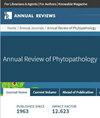Mycovirus Diversity and Evolution Revealed/Inferred from Recent Studies.
IF 11.9
1区 农林科学
Q1 PLANT SCIENCES
引用次数: 43
Abstract
High-throughput virome analyses with various fungi, from cultured or uncultured sources, have led to the discovery of diverse viruses with unique genome structures and even neo-lifestyles. Examples in the former category include splipalmiviruses and ambiviruses. Splipalmiviruses, related to yeast narnaviruses, have multiple positive-sense (+) single-stranded (ss) RNA genomic segments that separately encode the RNA-dependent RNA polymerase motifs, the hallmark of RNA viruses (members of the kingdom Orthornavirae). Ambiviruses appear to have an undivided ssRNA genome of 3∼5 kb with two large open reading frames (ORFs) separated by intergenic regions. Another narna-like virus group has two fully overlapping ORFs on both strands of a genomic segment that span more than 90% of the genome size. New virus lifestyles exhibited by mycoviruses include the yado-kari/yado-nushi nature characterized by the partnership between the (+)ssRNA yadokarivirus and an unrelated dsRNA virus (donor of the capsid for the former) and the hadaka nature of capsidless 10-11 segmented (+)ssRNA accessible by RNase in infected mycelial homogenates. Furthermore, dsRNA polymycoviruses with phylogenetic affinity to (+)ssRNA animal caliciviruses have been shown to be infectious as dsRNA-protein complexes or deproteinized naked dsRNA. Many previous phylogenetic gaps have been filled by recently discovered fungal and other viruses, which have provided interesting evolutionary insights. Phylogenetic analyses and the discovery of natural and experimental cross-kingdom infections suggest that horizontal virus transfer may have occurred and continue to occur between fungi and other kingdoms. Expected final online publication date for the Annual Review of Phytopathology, Volume 60 is August 2022. Please see http://www.annualreviews.org/page/journal/pubdates for revised estimates.从最近的研究中揭示/推断的真菌病毒多样性和进化。
对各种真菌进行高通量病毒组分析,从培养或非培养来源,导致发现具有独特基因组结构甚至新生活方式的各种病毒。前一类的例子包括splipalmivirus和ambiavirus。splipalmivirus与酵母菌纳纳病毒相关,具有多个正义(+)单链(ss) RNA基因组片段,它们分别编码RNA依赖的RNA聚合酶基序,这是RNA病毒(Orthornavirae领域的成员)的标志。双病毒似乎具有3 ~ 5kb的未分裂的ssRNA基因组,其中两个大的开放阅读框(orf)被基因间区隔开。另一种narna样病毒群在一个基因组片段的两条链上有两个完全重叠的orf,其长度超过基因组大小的90%。分枝病毒表现出的新的病毒生活方式包括yado-kari/yado-nushi性质,其特征是(+)ssRNA yadokariv与不相关的dsRNA病毒(前者的衣壳供体)之间的伙伴关系,以及被感染菌丝均质中RNase可接近的无衣壳10-11节段(+)ssRNA的hadaka性质。此外,与(+)ssRNA动物冠状病毒有亲缘关系的dsRNA多分枝病毒已被证明以dsRNA-蛋白复合物或去蛋白化裸dsRNA的形式具有传染性。最近发现的真菌和其他病毒填补了许多以前的系统发育空白,这些病毒提供了有趣的进化见解。系统发育分析以及自然和实验跨界感染的发现表明,真菌和其他界之间可能已经发生并继续发生水平病毒转移。预计《植物病理学年鉴》第60卷的最终在线出版日期为2022年8月。修订后的估计数请参阅http://www.annualreviews.org/page/journal/pubdates。
本文章由计算机程序翻译,如有差异,请以英文原文为准。
求助全文
约1分钟内获得全文
求助全文
来源期刊

Annual review of phytopathology
生物-植物科学
CiteScore
16.60
自引率
1.00%
发文量
19
期刊介绍:
The Annual Review of Phytopathology, established in 1963, covers major advancements in plant pathology, including plant disease diagnosis, pathogens, host-pathogen Interactions, epidemiology and ecology, breeding for resistance and plant disease management, and includes a special section on the development of concepts. The journal is now open access through Annual Reviews' Subscribe to Open program, with articles published under a CC BY license.
 求助内容:
求助内容: 应助结果提醒方式:
应助结果提醒方式:


